

Our solar system consists of one star, a family of eight (or is it nine?) planets, at least 184 moons (as of 2017), thousands of asteroids, and billions of meteoroids and comets. In terms of mass however, the solar system consists of very little else than the Sun itself. This ball of gas comprises 99.87% of the mass of the solar system and most of the remaining 0.13 percent resides in Jupiter. Thus most of the solar system is empty space. From the nearest star, using technology currently available on Earth, nothing could be seen of our solar system except the Sun, and it would appear only as a small yellowish star of a type common in the galaxy. Nonetheless, our new knowledge about the planetary objects that orbit the Sun is extremely important and is changing the way we look at the solar system and Earth itself.
In the annals of history, the last fifty years may well be remembered more for the exploration of the planets than for any other single achievement of the human race. No other generation has had the opportunity to reach beyond our own world and see, touch, and hear the forces that shape our universe. Our objective in this chapter is to introduce you to the results of this vast undertaking by making a brief survey of the nature of the major planetary objects in our solar system.
By tradition, it has generally been assumed that there is a clear-cut distinction in the hierarchy of planets, moons, asteroids, and interplanetary debris (planets being the larger objects that orbit the Sun, and moons being smaller and orbiting a planet). As a result of the recent exploration of space we are now obliged to look at the solar system differently. The solar system is really made up of 26 worlds larger than 1000 km in diameter; each distinct from the others. These worlds record a variety of events in planetary evolution and shed spectacular new light on the origin and history of our own planet, Earth. The traditional practice of classifying objects in the solar system as planets, moons, asteroids, comets, or meteorites establishes artificial categories that may blur important similarities.
Planets are spherical objects that orbit (or revolve) around a central luminous star and are large enough to have "cleared" out their orbit (Figure 1.1). Our Sun is a medium-sized star, which like other stars generates energy by nuclear fusion at high temperatures.

The Sun is only one of about 100 billion stars that collectively form a slowly rotating spiral galaxy (Figure 1.2). Planets are commonly solid, but liquids and gases are also important constituents. Planets are too small for nuclear fusion reactions to have initiated within their interiors. The principal planets in order outward from the Sun are Mercury, Venus, Earth, Mars, Jupiter, Saturn, Uranus, Neptune, and Pluto. A planetary body is a general term referring to any body orbiting a star. Planetary bodies include planets and their natural satellites or moons, as well as smaller objects such as asteroids and comets. They range in size from the small asteroids to the largest of the planets.
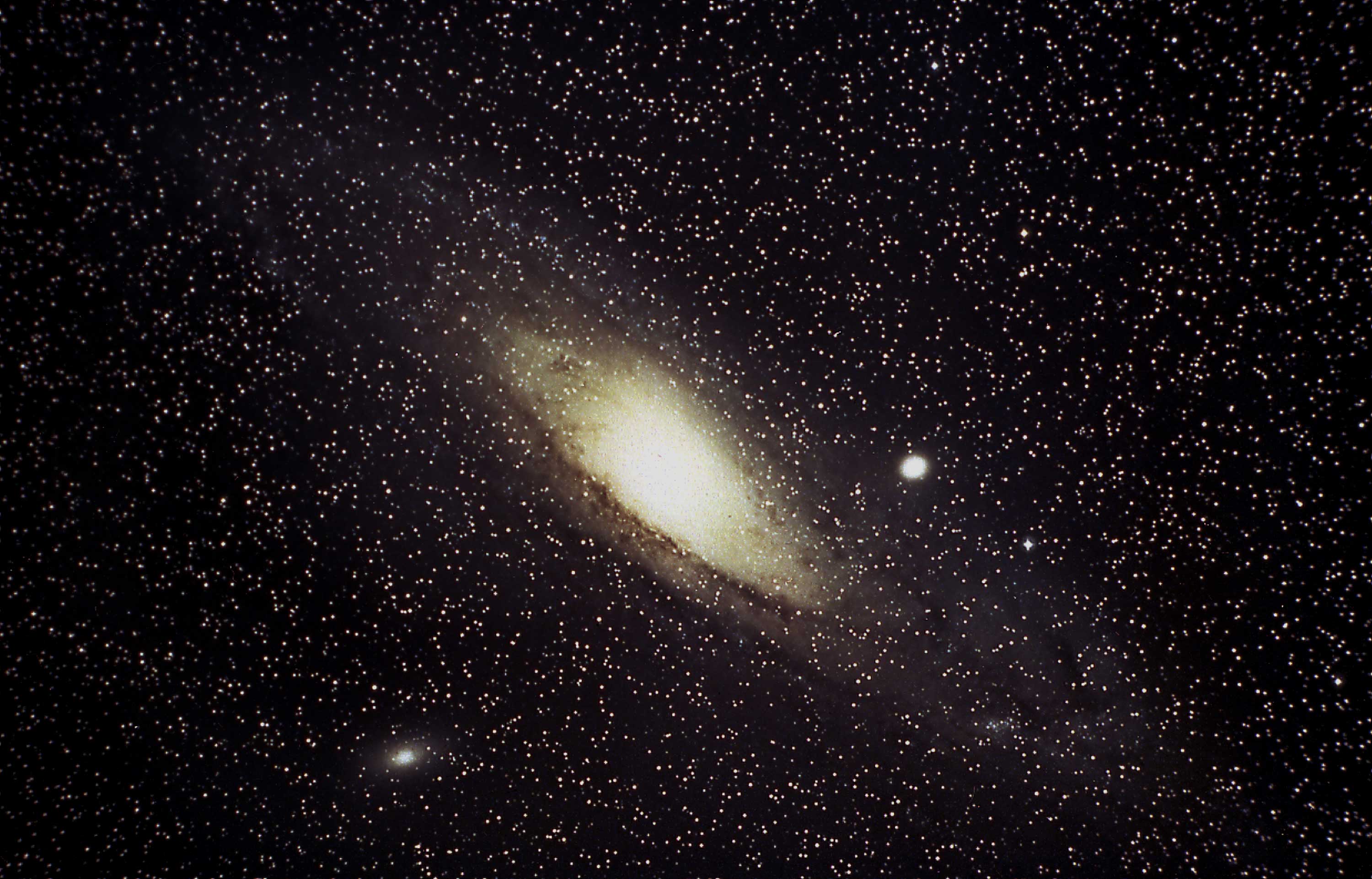
The relative sizes of the major planetary bodies in the solar system are shown in Figure 1.3. Descriptive information about the planetary objects discussed in this book is listed in Table 1.1; it is most useful for comparative purposes. The inner planets (Mercury, Venus, Earth, and Mars) are also called the terrestrial planets (Earth-like). They are relatively small worlds composed of silicate (silicon-oxygen compounds) rock surrounding metallic cores. Farther from the Sun lie the four gas giants, with deep atmospheres that thicken downward into hot liquid, probably surrounding small, solid rocky or icy cores. These planets have no solid surfaces. Jupiter, Saturn, Uranus, and Neptune all have rings of small particles that encircle them. The outermost and smallest planet is Pluto. Natural satellites, or moons, orbit every planet except Mercury and Venus. The satellites (planetary bodies that revolve around a planet) of Earth and Mars are composed of silicate rock. Jupiter has a miniature planetary system comprised of four large moons and at least 69 smaller ones (as of 2017). The larger moons have rocky cores, which are covered with thick mantles of water ice. Saturn is also the center of a miniature planetary system, involving more than 62 planetary bodies. The moons of Saturn are relatively small icy worlds (except for Titan, which is larger than Mercury) with rocky cores. Uranus and Neptune also have many small icy satellites (27 and 14 respectively) . Pluto's moons (5) resemble the icy satellites of Uranus and Neptune.
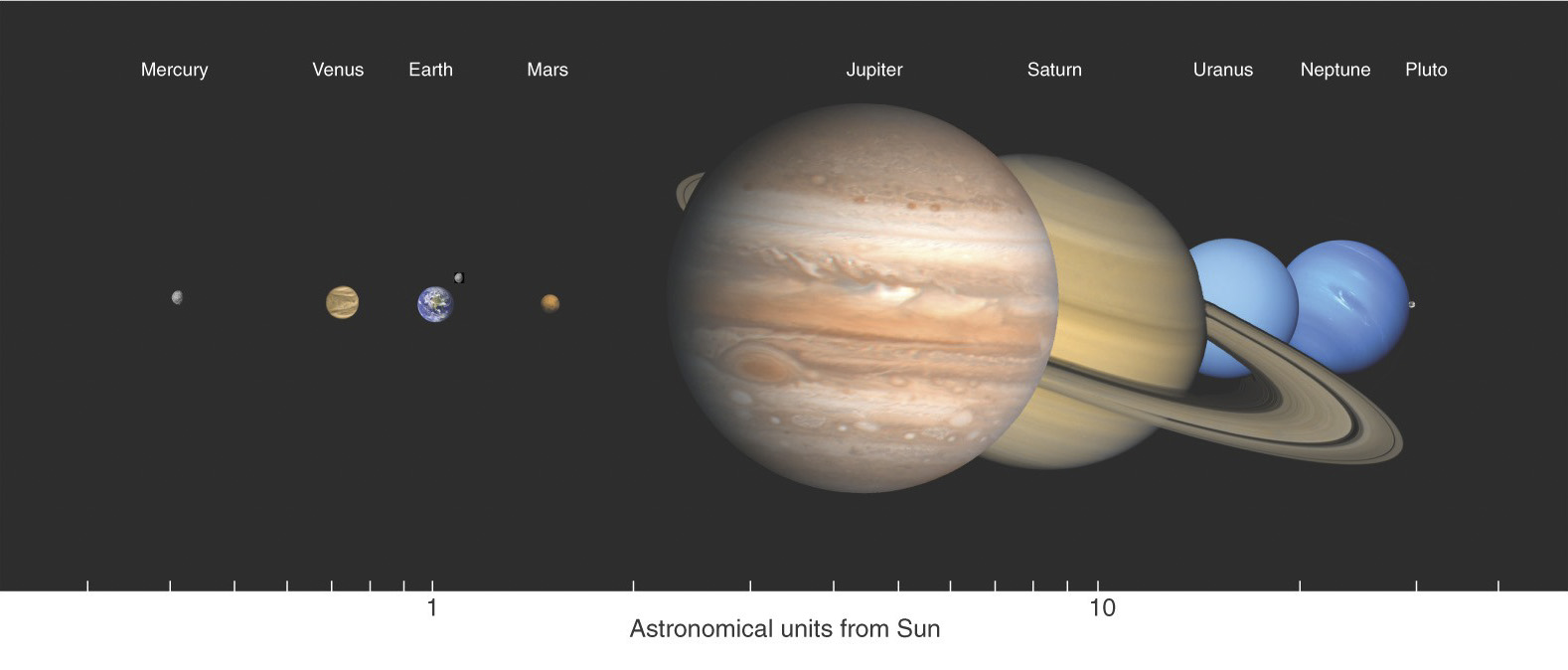
Most of the information summarized below and throughout the rest of this book is the result of the space programs of the United States and the former Soviet Union. Table 1.2 lists the dates and goals for the most important missions. Most of these missions were accomplished by unmanned robotic explorers, but the work of the Apollo astronauts in the late 1960s and early 1970s on the Moon may represent the pinnacle of human exploration in space.
Mercury is the innermost planet (Table 1.1). It orbits the Sun at only 40 percent of the distance that Earth lies from the Sun. With no atmosphere to moderate its environment, the temperature range at the surface is extreme, from 90 K on the surface turned away from the Sun to about 740 K on the surface facing the Sun. No clouds hide Mercury's surface, which is dominated by circular craters formed when large meteorites struck it (Figure 1.4). Many of the craters are extremely ancient, between 3 and 4 billion years old. The largest impact crater shown here is almost 1300 km across. Broad patches of smooth plains, deformed by a system of wrinkles, occur between the craters. The plains may have been produced when the interior warmed and partially melted to produce lavas, which were then erupted onto the surface. Mercury appears to be composed of rocky materials similar to the other terrestrial planets. A magnetic field and a high bulk density (mass/volume) for Mercury hint at the presence of an iron-rich interior that may still be partially molten.
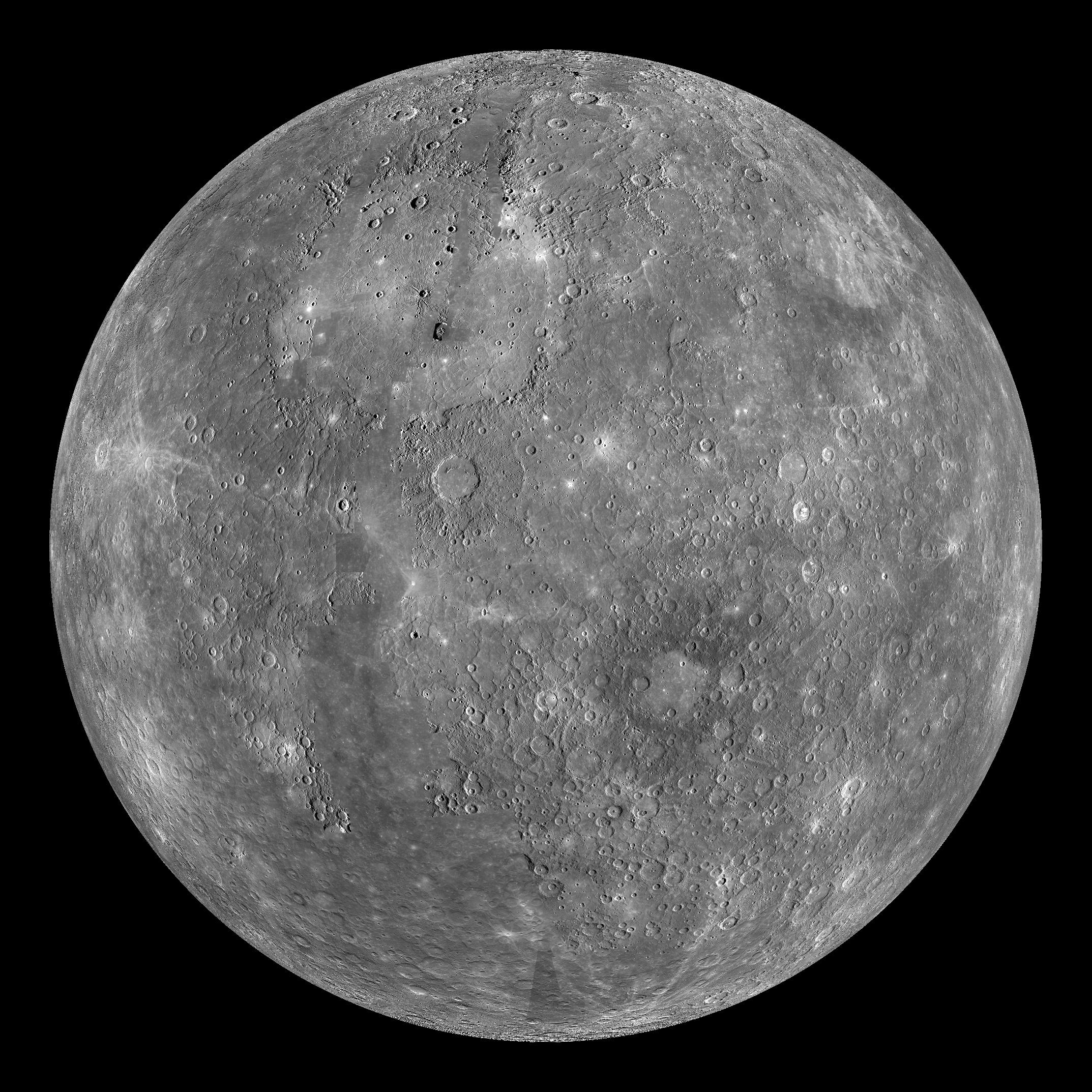
Considered Earth's twin because of its similar size and composition it is nearly two and a half times larger than Mercury and farther from the Sun, Venus stands in striking visual contrast to Mercury (Figure 1.4). Its orbit is closer to a perfect circle than any of the planets, yet it moves in odd ways. Its rotation is retrograde or backward and its spin is so slow that eight Earth months go by during the time Venus spins once on its axis. In addition, Venus orbits the Sun in less than the time it takes for one rotation on its axis. The surface of Venus is totally obscured by a thick atmosphere composed mostly of carbon dioxide with sulfuric acid clouds (Figure 1.5). Nonetheless, Soviet and American spacecraft using radar instruments have revealed the details of the planet's surface features. Impact craters, formed when large meteorites slammed into the surface, are scattered sparsely across the landscape. Mountain belts, volcanoes, and highlands rise several kilometers above vast rolling plains, forming a surface similar in some ways to Earth with its continents and ocean basins. However, Venus has no liquid water and temperatures at its surface (almost 750 K) are higher than on Mercury.
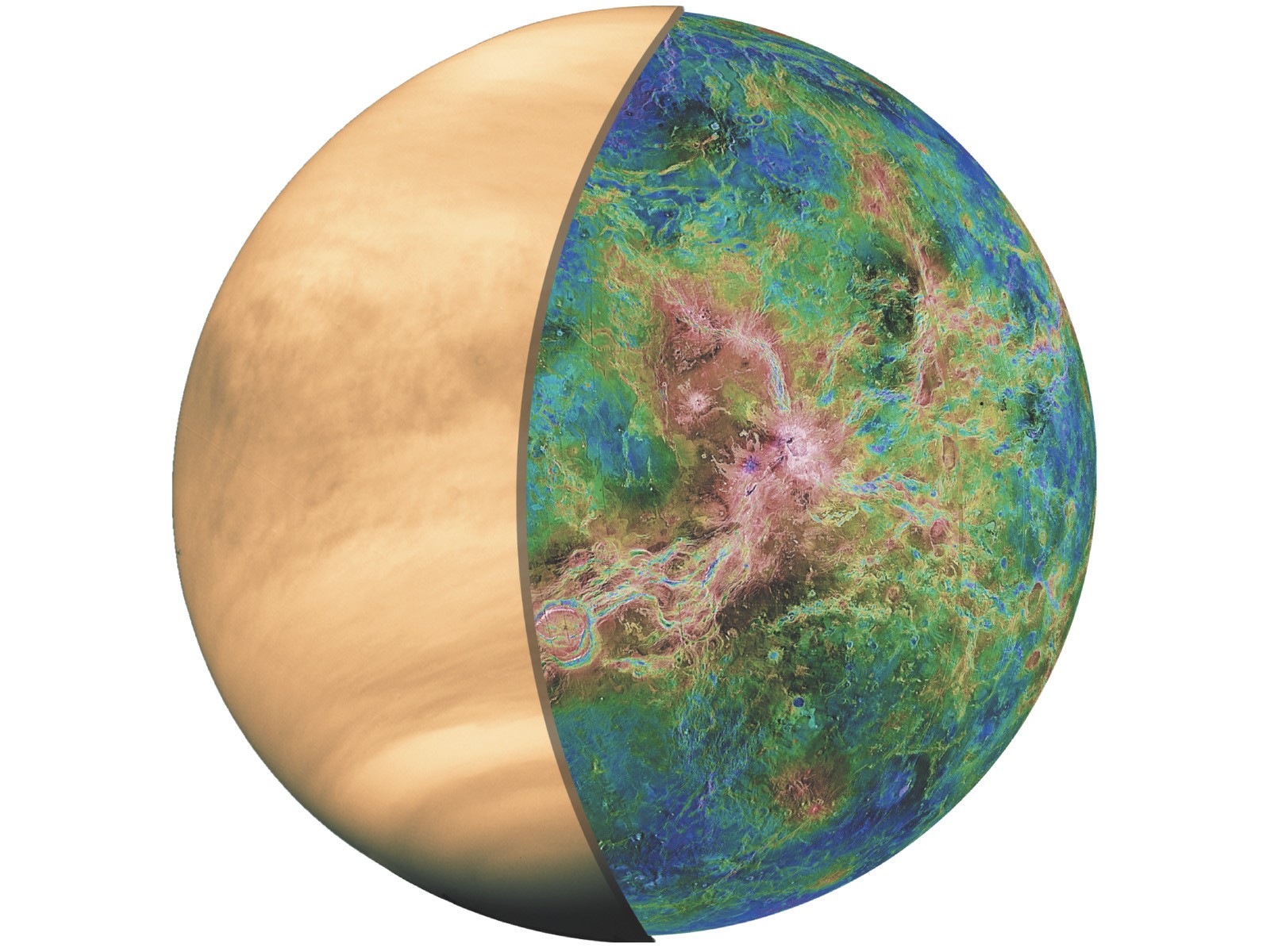
The third planet from the Sun, Earth, is dominated by the liquid water of its oceans and the white swirling patterns of clouds, underlining the importance of the atmosphere and of water for the development of the surface features of Earth. Several complete cyclonic storms, spiraling over hundreds of square kilometers, are illustrated in Figure 1.6. They pump huge quantities of water from the ocean to the atmosphere. Much of this water is precipitated on the continents and erodes the land as it flows back to the sea. Earth's poles are marked by ice caps---the Antarctic continent, shown here, is covered by a polar ice cap which is 3 km deep in places. Huge oceans of liquid water cover 70 percent of the planet. Rising above the oceans, Earth's continental highlands are etched by delicate systems of river valleys. In this view, large parts of the continental highlands of Africa and Antarctica are also visible above the level of the sea. In striking contrast to some of the other inner planets, no impact craters are visible from this distance. Indeed, such structures are rare on Earth, and most of its rocks are less than 2.5 billion years old. Its landforms are extremely young, shaped by the relentless flow of water and wind. Of particular interest in this view is the rift system of the Red Sea, a large growing fracture in the African continent that separates Arabia from Africa. This fracture attests to the mobility of Earth's lithosphere, its outer solid layer. The lithosphere is fragmented, and each segment moves slowly about the planet. Active volcanoes and earthquakes still produce dramatic changes at the surface. Self-replicating molecules of carbon, hydrogen, nitrogen, and oxygen---life---developed early in Earth's history; they have substantially modified the planet's surface, blanketing huge parts of the continents with greenery. Tropical jungles create the dark band across equatorial Africa, dramatic evidence of the unique chemistry of Earth. Life thrives on this planet, which has an oxygen and nitrogen-rich atmosphere and moderate temperatures (generally above 275 K). Perhaps if nothing more, our studies of the diversity of compositions and conditions of solar system bodies should remind us of the delicate balance of energy, environment, and evolution which allows us to exist at all.
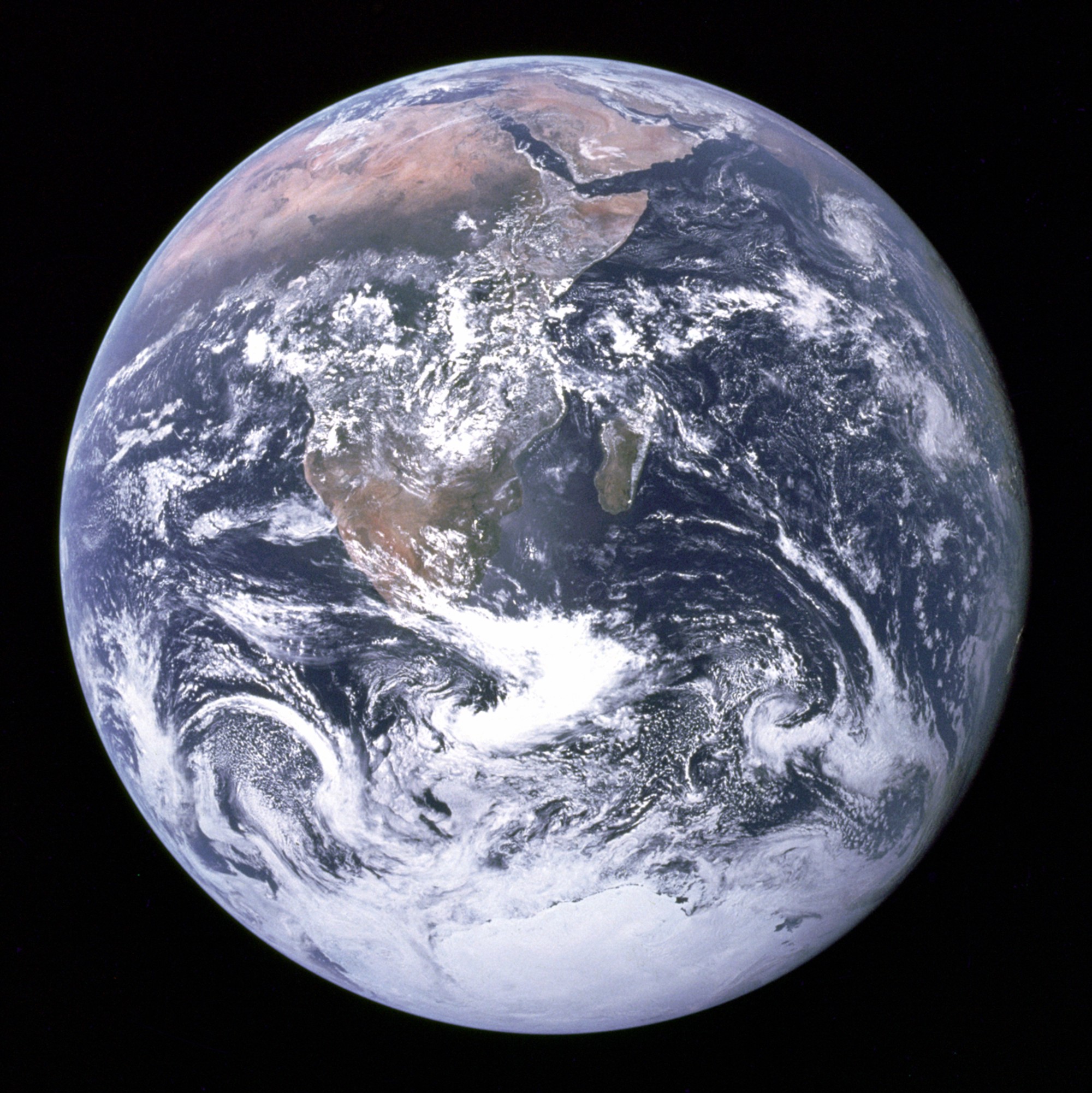
With the developments of the space program the Moon, Earth's natural satellite, has become one of the best-understood planetary bodies in the solar system. As curious as it may seem, we probably understand the earliest history of the Moon better than that of Earth. This is because Earth lacks a rock record of its first 800 million years of history while the Moon does not. The surface of the Moon (Figure 1.7) shows two contrasting types of landforms, which reflect two major periods in its history. The bright, densely cratered highlands are similar to the surface of Mercury. Most of the large impact craters formed before about 4 billion years ago. The dark, smooth areas are called maria and most occupy low regions, such as the circular interiors of impact basins. We know from rock samples brought back by the Apollo astronauts that the maria resulted from great floods of lava, which filled many large craters and spread out over the surrounding area. The volcanic activity therefore occurred after the formation of the densely cratered terrain. Radiometric dates on samples brought back from the Moon indicate that most of the lavas are over 3 billion years old. Some young impact craters with bright rays formed after these eruptions. Like Mercury, the Moon is a dry airless world. The lunar surface has not been modified by wind, water, or glaciers, but its surface features record major events early in the history of the solar system, when impact of meteorites was the major geologic process throughout the solar system.
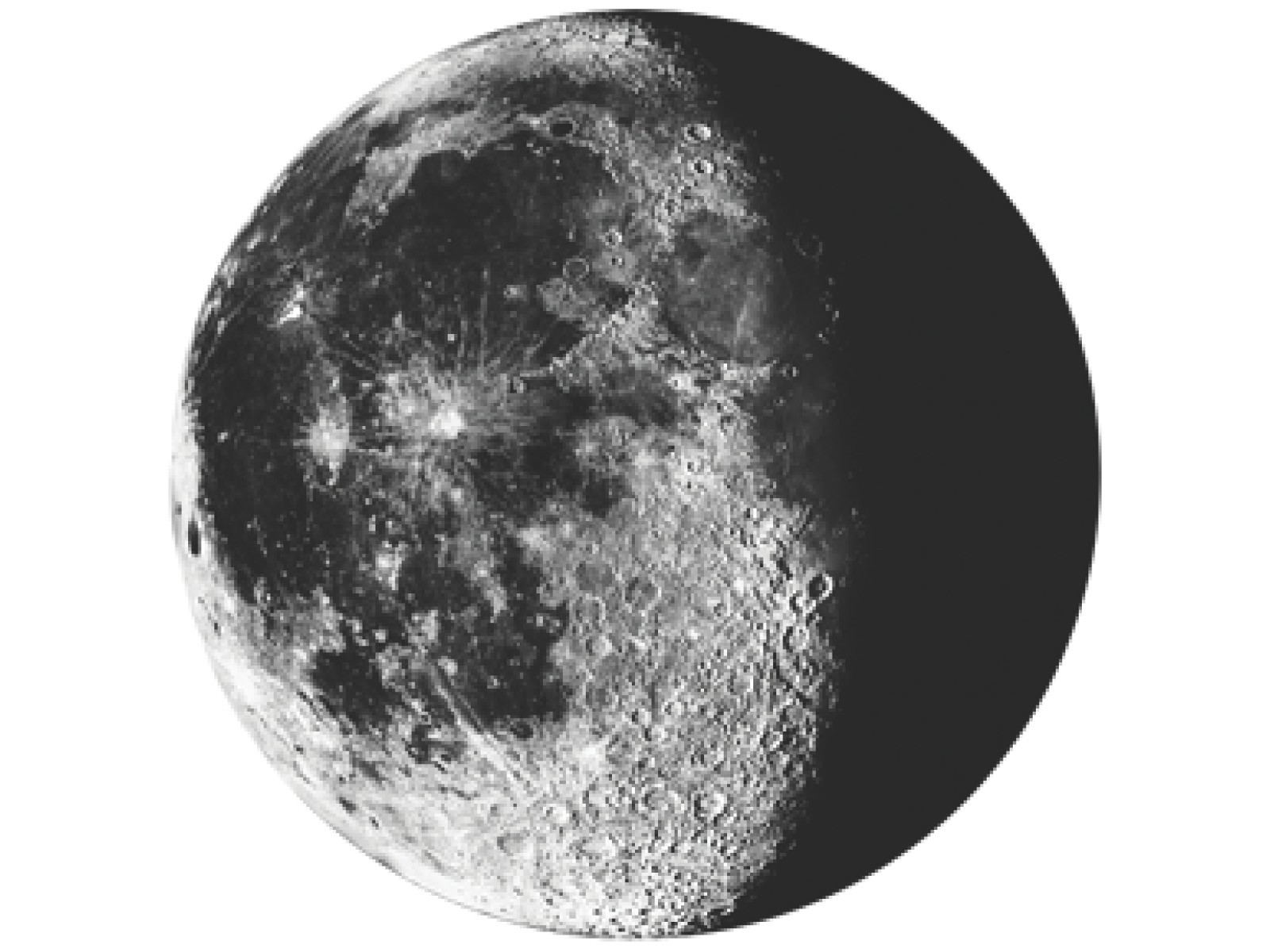
Mars, the red planet, is smaller and less dense than Earth. For years it was considered to be a planet of mystery because telescopic observations revealed a thin atmosphere, polar ice caps, and shifting markings, which often darkened during the martian spring. Some thought that Mars was populated and that life forms had evolved to a civilized state. Streaks were believed to be canals or vegetated land alongside canals. As it turns out, these fanciful theories were all wrong, but in a different way the real Mars is just as fascinating. Unlike the Moon, many features of Mars indicate that its surface has been modified by atmospheric processes, running water, recent volcanic activity, and lithospheric deformation. Its surface is divided into two distinctly different hemispheres (Figure 1.8). The northern hemisphere has few meteorite impact craters and consists of vast, relatively smooth plains. The ancient southern hemisphere, in contrast, is higher and moderately to heavily cratered. A broad fractured swell capped by several great volcanoes overlaps the boundary between the hemispheres. Huge channels, apparently carved by running water, course across the surface of Mars. Liquid water cannot exist at its surface today, yet Mars has had abundant liquid water on its surface in the past. What happened? The question will be debated for years but one thing seems certain: Mars has experienced significant changes during its history---changes recorded on its surface and in its landscapes, changes that are still occurring---as evidenced by planetwide dust storms, wind-blown sand, tenuous mists, and clouds.
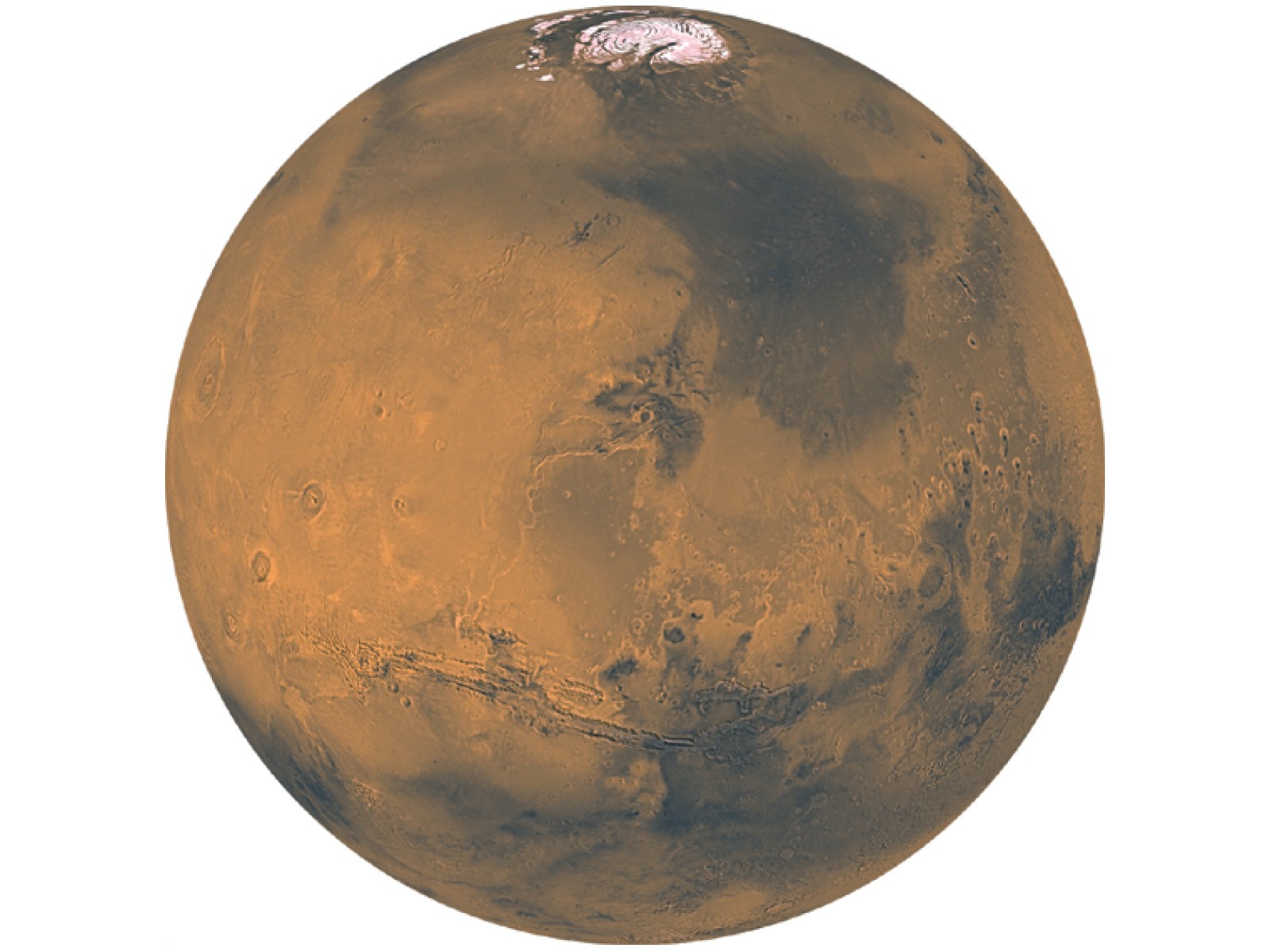
Occupying the vast tract between Mars and Jupiter is the asteroid belt. It consists of thousands of small bodies ranging from less than 1 to just over 1000 km in diameter. The asteroids mark the transition from the rocky terrestrial planets to the gas- and ice-rich outer planets. Some asteroids appear to be rocky, some seem covered with lavas, others seem to be metallic, and yet others may have water ice. Many meteorites are derived from the asteroids. Meteorites are small planetary bodies composed of iron or silicate rock that reach Earth from space. Called meteoroids before they hit a planet, they are actually fragments of asteroids or comets (and more rarely of moons or planets). These pieces of planetary material are extremely valuable because they provide scientists with tangible samples of planetary bodies that can be analyzed in great detail. Moreover, expensive spacecraft are not necessary to obtain them.
Jupiter is the largest planet in the solar system; in fact, most of the mass of the solar system outside of the Sun is in Jupiter. Jupiter has no solid surface. The spots and colorful bands (Figure 1.9) that parallel its equator are the turbulent manifestations of motion in a thick, cloudy atmosphere of hydrogen and helium. Jupiter and the other outer planets have compositions dramatically different from the rocky inner planets. In addition, Jupiter is the center of a miniature planetary system and a narrow ring. It has four large moons, which are called the Galilean satellites, because they were discovered by Galileo in the 1600s. Two of these moons are nearly the size of Mercury and all four are larger than Pluto. Each has diverse surface features resulting from meteorite impact, volcanism, and surface fracturing. Like the principal planets, these satellites show significant compositional changes outward from their primary.
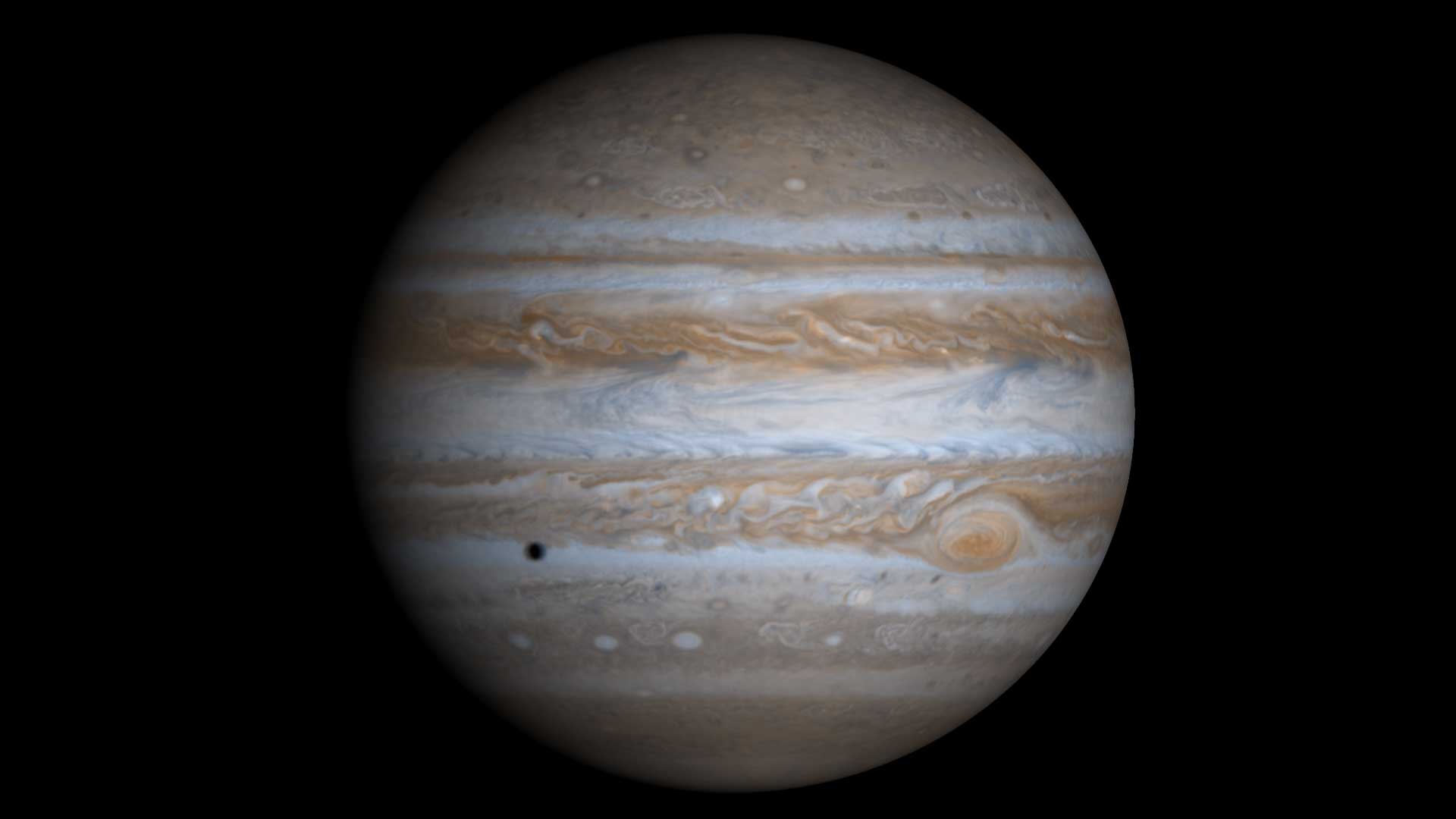
The innermost Galilean satellite appears to be one of the most bizarre worlds in the solar system. The density of Io is about the same as Earth's Moon, which suggests that Io has a rocky, rather than an icy composition. Io is only slightly larger than the Moon, but it has no impact craters. Instead, its surface is dominated by mottled patches in colors of yellow, red, and white, with black pockmarks (Figure 1.10). In 1979, eight active volcanoes were seen on Io by the Voyager 1 spacecraft; four months later, when Voyager 2 flew by, at least six of these volcanoes were still erupting and two new ones had started. Close-up photos reveal that most of the black spots on Io are volcanic craters or calderas. Io must have abundant thermal energy to drive its active volcanoes but it is about the same size as the cold, dead Moon. Much of the surface coloration is caused by various forms of sulfur. Estimates of the thickness of sulfur at the surface range from a thin frosting a few millimeters thick to a globe-encircling layer several kilometers thick.
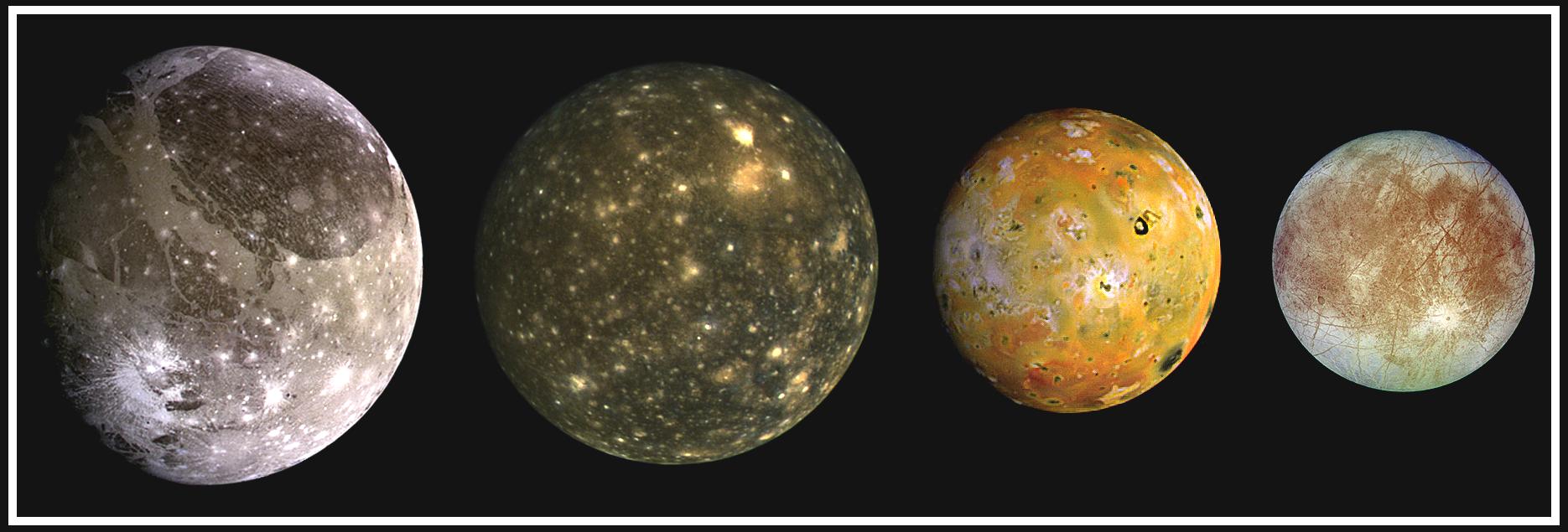
The surface of Europa is composed of bright water ice and is distinctive in that it is almost perfectly smooth. Local relief is only a few hundred meters. The major surface features are sets of tan streaks or bands (Figure 1.10). Indeed, it has been said the Europa looks like an icy billiard ball with lines drawn on it with a felt-tip pen. What are the bands? Most appear to be shallow valleys up to 75 km across that extend as far as 3000 km across the surface. They appear to be similar to fractured sea ice in the polar regions of Earth. Internal heat apparently formed a watery slushy "lava," which erupted through cracks and fissures in the crust and coated the surface with fresh new ice. The near-absence of impact craters on Europa suggests that the surface is very young, formed after the early periods of heavy meteorite bombardment that scarred the ancient surfaces of Mercury and the Moon. Resurfacing by eruption of watery lavas has continued to relatively recent times.
Ganymede is the largest satellite in the solar system. Its surface contains a baffling array of structural and volcanic features unlike anything in the solar system. Many features appear to result from breaking and lateral movement of lithospheric fragments, so it was with great interest that geologists studied the details shown on the Voyager photographs. The view shown in Figure 1.10 reveals that on a global scale Ganymede has two distinct terrain types. The older is dark and nearly saturated with craters. This is believed to be an old terrain composed of "dirty ice" containing dust and particles from space. This older crust on Ganymede has been fractured and split apart, and many of the fragments have shifted about. The brighter, younger terrain is crossed by a spectacular series of narrow grooves and stripes, features that result from deformation and cracking of an icy crust.
Callisto is the outermost Galilean satellite; like Ganymede it is believed to consist of a rocky core surrounded by a thick mantle of ice. The images sent back from Voyager spacecraft show that Callisto, in contrast to the other Galilean satellites, is saturated with craters, somewhat like the highlands of the Moon (Figure 1.10). The general surface of Callisto is dark, dirty ice, but many craters have bright rays and ejecta blankets. The bright material is probably clean melted ice ejected from impact. The surface of Callisto is believed to be very old, recording events during the early history of the solar system. Why did Callisto escape subsequent modification when the other Galilean satellites record more recent events? How do the events recorded on Callisto in the outer solar system compare with those preserved on the Moon and Mercury in the inner solar system? These and other questions will be considered as we explore the details of the geologic histories of the fascinating satellites of Jupiter.
Saturn is similar to Jupiter in many ways. It is a gigantic ball of mostly hydrogen and helium. Its atmosphere is not as colorful as Jupiter's, but is marked by dark bands alternating with lighter zones. The rings of Saturn are its most dramatic feature; they have intrigued astronomers for over 300 years (Figure 1.11). Now that we have seen them close up they are even more astonishing. They extend over a distance of 40,000 km and yet are only a few kilometers thick. The rings are probably made up of billions of particles of ice and ice-covered rock ranging from a few microns to a meter or more in diameter. Rarely are particles in the rings more than a kilometer in diameter. Each particle moves in its independent orbit around Saturn, producing an extraordinarily complex ring structure.
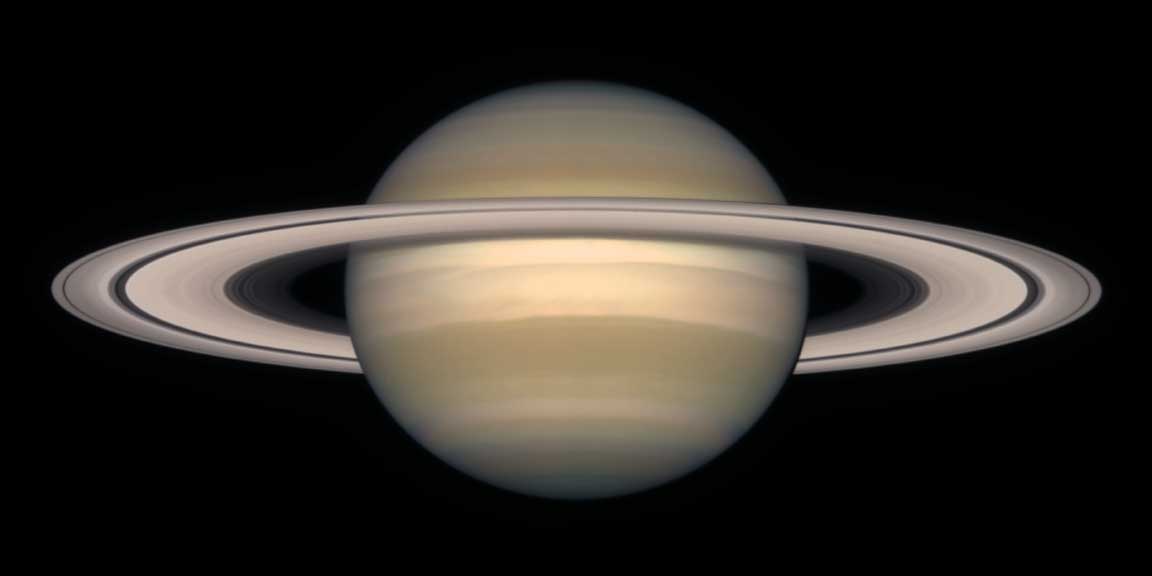
Like Jupiter, Saturn is the center of a planetary system, with an elaborate family of satellites. Except for Titan, which is in a class by itself, the moons of Saturn are small bodies of ice admixed with rocky silicate material. One might think that small icy moons would have little interest to the geologist---because of their cold origins, primitive compositional character, and apparent lack of an internal source of heat for any geologic activity. As it turns out, however, the moons of Saturn experienced many events, recorded in their surface features, which help us better understand the geology of the entire solar system.
The larger satellites (except for Titan) fall into convenient pairs that match their order from Saturn outward: Mimas and Enceladus (between 400 and 500 km in diameter), Tethys and Dione (between 1050 and 1120 km in diameter), and Rhea and Iapetus (about 1500 km in diameter).
Tiny Mimas, only 400 km across, is an icy body saturated with impact craters. Its most prominent feature is a huge crater, whose diameter is one-fourth that of the satellite itself (Figure 1.12). The impact that formed the crater must have come close to breaking Mimas into fragments. The opposite hemisphere contains large fractures, which may have been produced as shock waves from this impact traveled through the satellite.
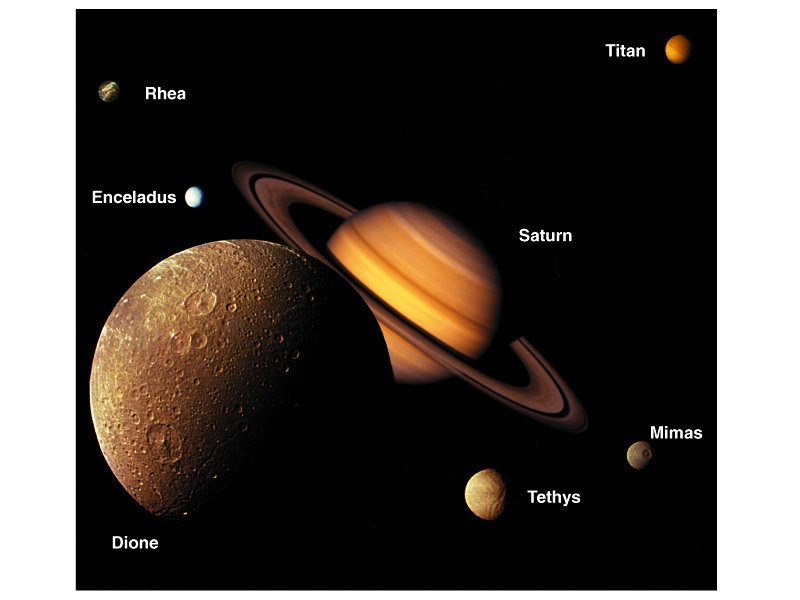
Enceladus is only slightly larger than Mimas but bears little resemblance to its nearest neighbor. Enceladus has very few impact craters and a complex grooved terrain, similar in some ways to that on Ganymede (Figure 1.12). It is unique among the Saturnian satellites in that it has large expanses of smooth icy plains on the flanks of a planetwide system of fractures. The plains may have been produced by "lavas" of icy slush erupted through these fissures covering many older impact craters. This terrain may be a result of heat generated by the variable tidal pull of Saturn and Dione. Such heat would soften the interior of Enceladus and could cause a type of volcanic activity that would resurface the satellite, creating some of the smooth plains and destroying older craters.
The most spectacular feature on the surface of Tethys is an enormous impact basin almost a third the diameter of Tethys itself (Figure 1.12). Heavily cratered Tethys is also scarred with a gigantic fracture system that extends as a continuous feature almost three-quarters of the way around the satellite. What events produced such gigantic features on such a small icy satellite? It has been suggested that Tethys has been fragmented by comet impact and reassembled under its own gravity into a fractured ball of icy debris, or perhaps it simply cracked as a result of global expansion of its icy interior. The density of Tethys, like that of several other Saturnian moons, is just slightly above that of pure water ice.
With its surface saturated with craters and its large, smooth areas that resemble the dark lunar plains, Dione looks much like Earth's Moon (Figure 1.12). Only slightly larger than Tethys, Dione has a sinuous fracture or trough that extends across a major portion of the moon's surface. Dark areas are crisscrossed with light streaks, which may be extrusions of material from its interior, forming a region called wispy terrain.
The surface of Rhea, photographed in finer detail than any of the other Saturnian satellites, has been found to be saturated with craters, much like the surfaces of Mercury and Earth's Moon (Figure 1.9). Very large craters, however, which are normally present in the crater populations on other planetary bodies in the solar system, are lacking on Rhea's surface---a fact that may alter our interpretation of the early history of cratering. Two periods of meteorite bombardment may have occurred throughout the solar system during its early history, but evidence of only the latter one is preserved on Rhea. An older cratered surface may have been smoothed over by ice flows from within the satellite. Rhea also has bright wispy bands superimposed on a dark background. The wisps have a cloudlike appearance, but Rhea has no atmosphere.
Iapetus circles Saturn in a lonely orbit nearly three times as far away as Titan or Hyperion, the next closest satellites. Iapetus is slightly smaller than Rhea with a diameter of 1460 km. However, unlike Rhea, one hemisphere of Iapetus is covered with an exceptionally dark material that reflects so little light that it is similar to coal or soot (Figure 1.12). The boundaries of these unique dark areas are sharp but complex in detail. The dark material is even deposited on the floors of some large craters. Perhaps the dark material was derived from the interior of Iapetus in an exotic form of volcanism. Much of the rest of Iapetus appears to be heavily cratered.
Titan, the second largest satellite in the solar system, is the only one of Saturn's moons with an atmosphere (Figure 1.12). Haze in the atmosphere totally obscures Titan's surface and is responsible for its bland appearance. It is nearly the same size as airless Ganymede and Callisto, moons of Jupiter. Preliminary data indicate that its atmospheric pressure is 1.5 times that of the surface of Earth, and that its temperature is about 100 K. To the surprise of all, Titan's atmosphere is dominated by nitrogen, like Earth's, with only about one percent methane (CH4), along with such hydrocarbons as propane, ethylene, ethane, and acetylene. Remarkably, seas of hydrocarbons, instead of water, may exist on Titan!
Uranus is a gas- and ice-rich planet encircled by a narrow ring system (Figure 1.13). The rotation axis of Uranus has been flipped on its side, apparently by some early catastrophic collision with another body. In addition, Uranus has five major satellites larger than about 300 km in diameter and many smaller satellites. All of the satellites of Uranus (Figure 1.14) appear to be icy, like those of Saturn.
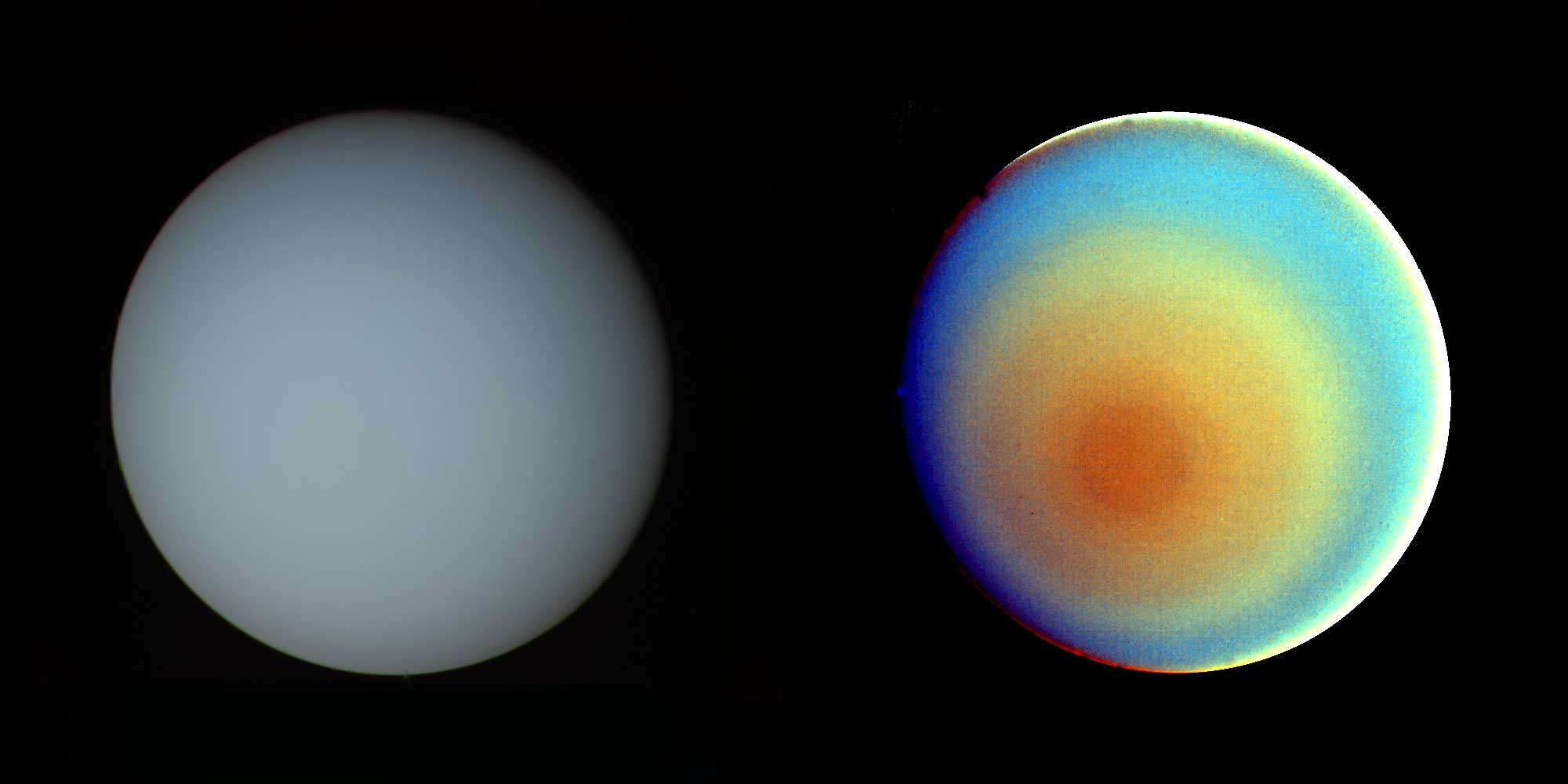
About the size of Saturn's tiny moon Mimas, Miranda is not a simple crater-dominated sphere. Large ovoidal patches disrupt its surface and appear to be unique in the solar system. Oberon and Umbriel, respectively about three and two times the size of Miranda, have heavily cratered surfaces that appear to have been little modified by volcanism or fracturing. In contrast, the surfaces of Titania and Ariel reveal that some sort of icy volcanism and fracturing has shaped their landforms.

Neptune, with its beautiful blue atmosphere, was the last of the planets visited by the Voyager spacecraft. Neptune (Figure 1.15) is only slightly smaller than Uranus, and it appears to be similar to its neighbor in its composition. Both planets, called the twins of the outer solar system, are thought to have large cores of water ice and rock surrounded by thick atmospheres of hydrogen, helium, and minor methane.
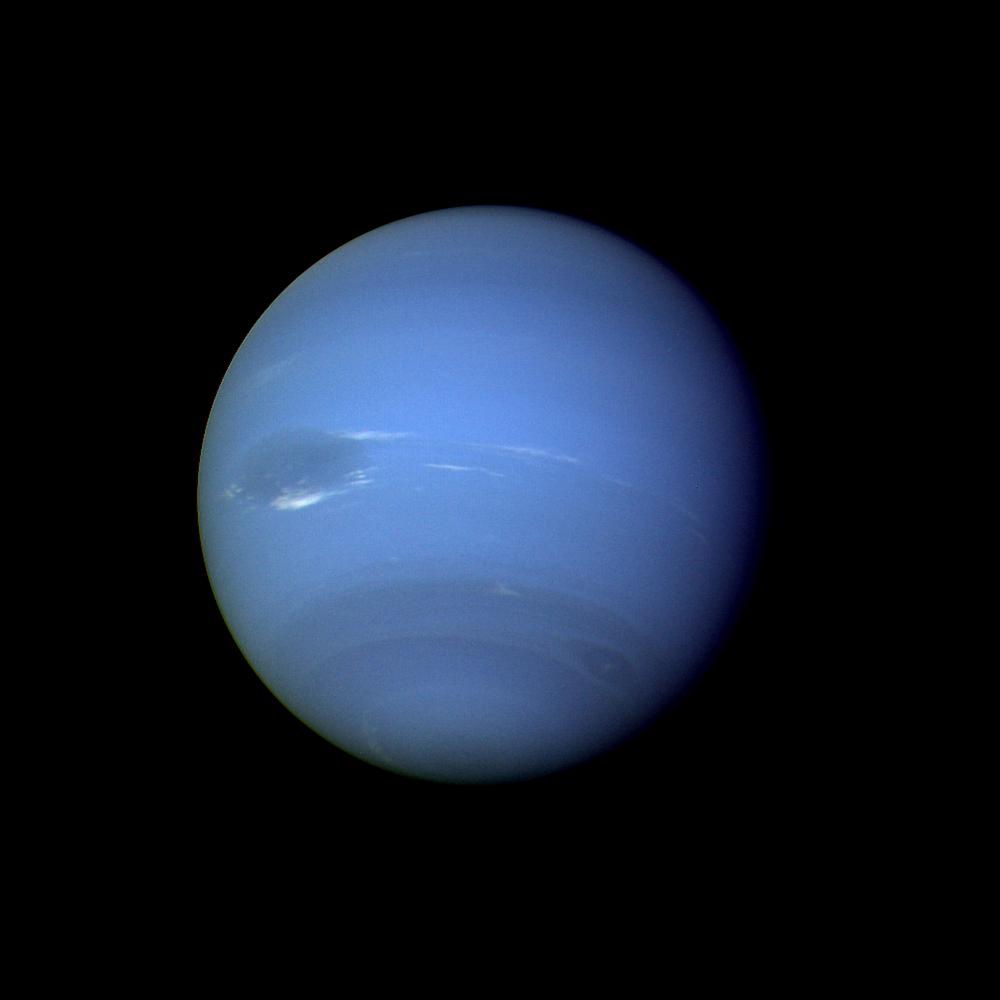
Only two moons were known to orbit Neptune before the Voyager spacecraft passed it in August of 1989. Six more dark moons were discovered during Voyager's brief flyby. Triton (Figure 1.16) is slightly smaller than Jupiter's Europa and has an atmosphere of nitrogen and methane. Its exotic surface is covered by ices of those gases. Impact craters are not common on its surface, unlike most of the other small satellites of the outer solar system. Active geysers fountaining gas and dark dust were photographed. Nereid is much smaller, perhaps the size of Uranus' Miranda, and has an extremely eccentric (noncircular) orbit. One of the newly discovered moons, Proteus, is larger than Nereid.
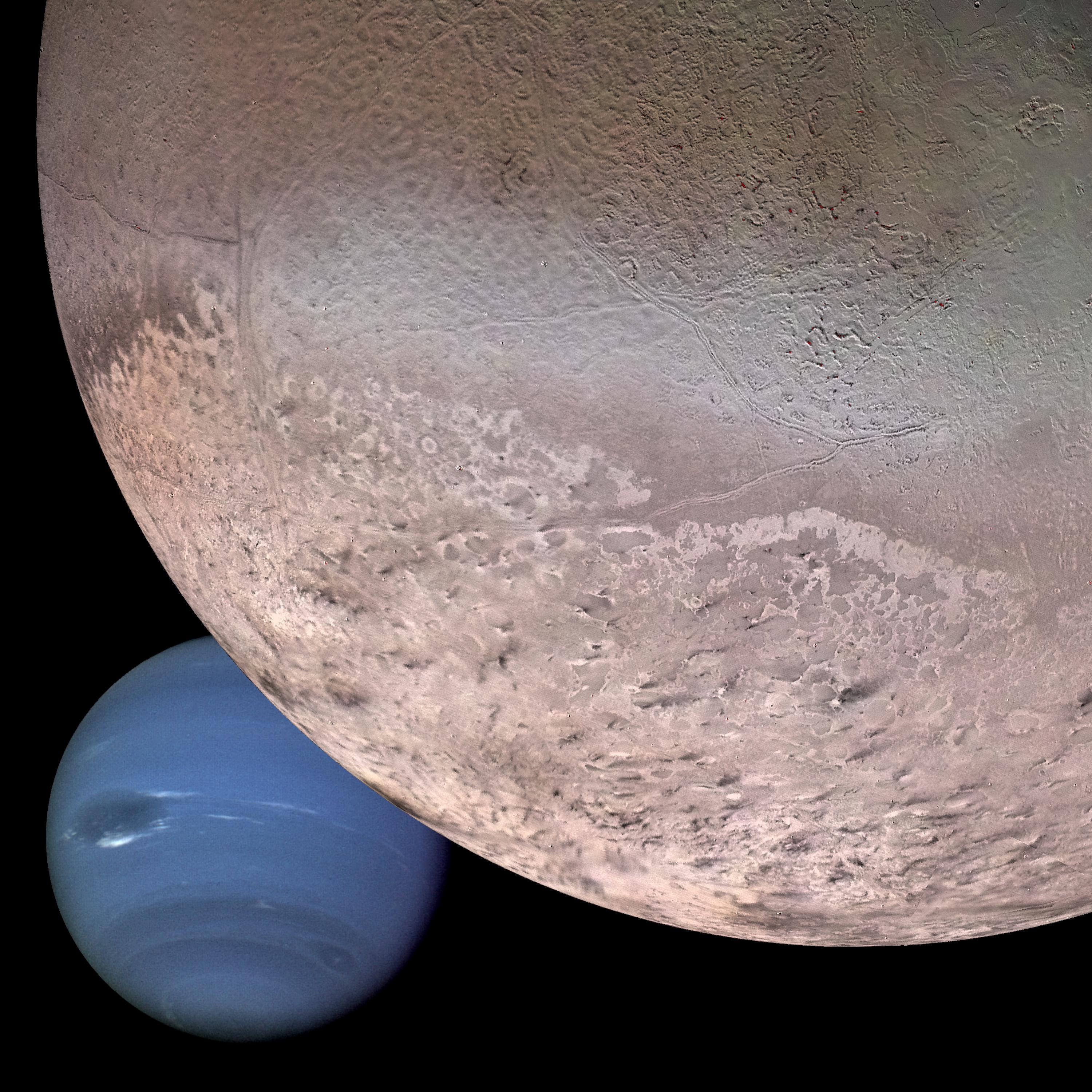
Tiny Pluto was discovered in the remote margins of the solar system in 1930. It is truly a planet of extremes, the smallest, the darkest, the coldest, and certainly the most distant. Its orbit surrounds Earth's like an elliptical Hula-Hoop encircling a wedding ring. For years little was known about this planet, but recently enough data have been obtained to establish some of its physical properties. As it turns out, Pluto is hardly larger than the Moon. Yet it was recently discovered that Pluto has a large moon of its own, called Charon, and some planetary scientists think of the pair as a double planet (Figure 1.17). Pluto is not a gas planet like its neighbors (Neptune, Uranus, Saturn, and Jupiter). It is a solid icy body more like Triton than anything else we have seen in the solar system. Its surface is covered by frozen nitrogen with traces of methane and carbon monoxide ice. Rock and water ice probably comprise its interior. Even at the very low temperatures found on Pluto (probably about 35 K), some of the nitrogen should sublimate (vaporize) to produce a thin atmosphere.
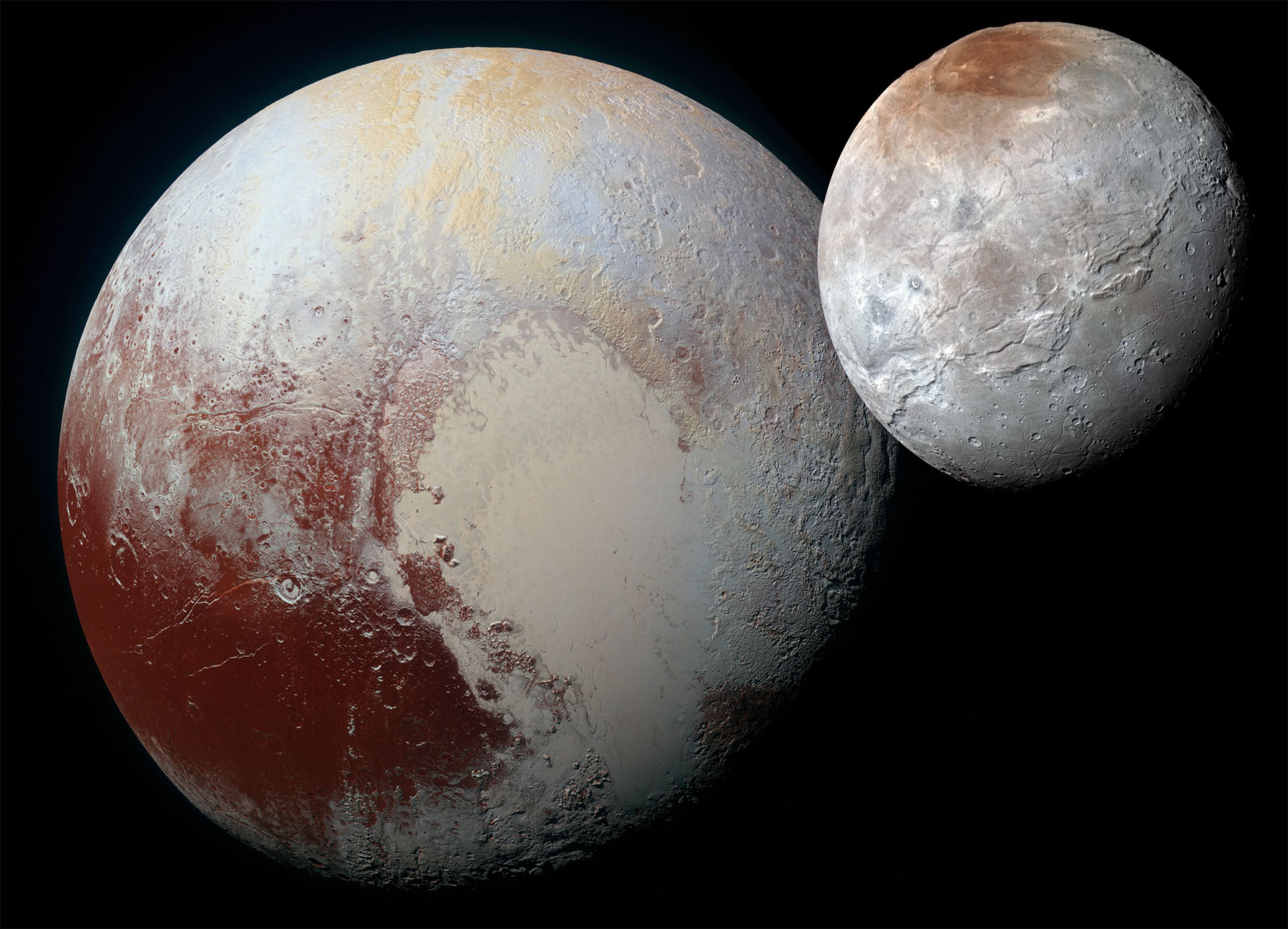
At even greater distances from the Sun, comets are the characteristic members of the solar family. Comets may preserve in their icy interiors some of the original materials from which the outer planets formed, so samples of comets are eagerly sought. Some comets have orbital periods of hundreds of thousands of years. The group of comets that occupies the outermost limits of the solar system is called the Oort cloud. These small balls of ice are only occasional visitors to the inner solar system, where they develop diffuse heads and long streaming tails (Figure 1.18) as the ices sublimate from the warmth of the Sun. Like other planetary bodies, comets glow as a result of reflection of light from the Sun; they are not self luminous.
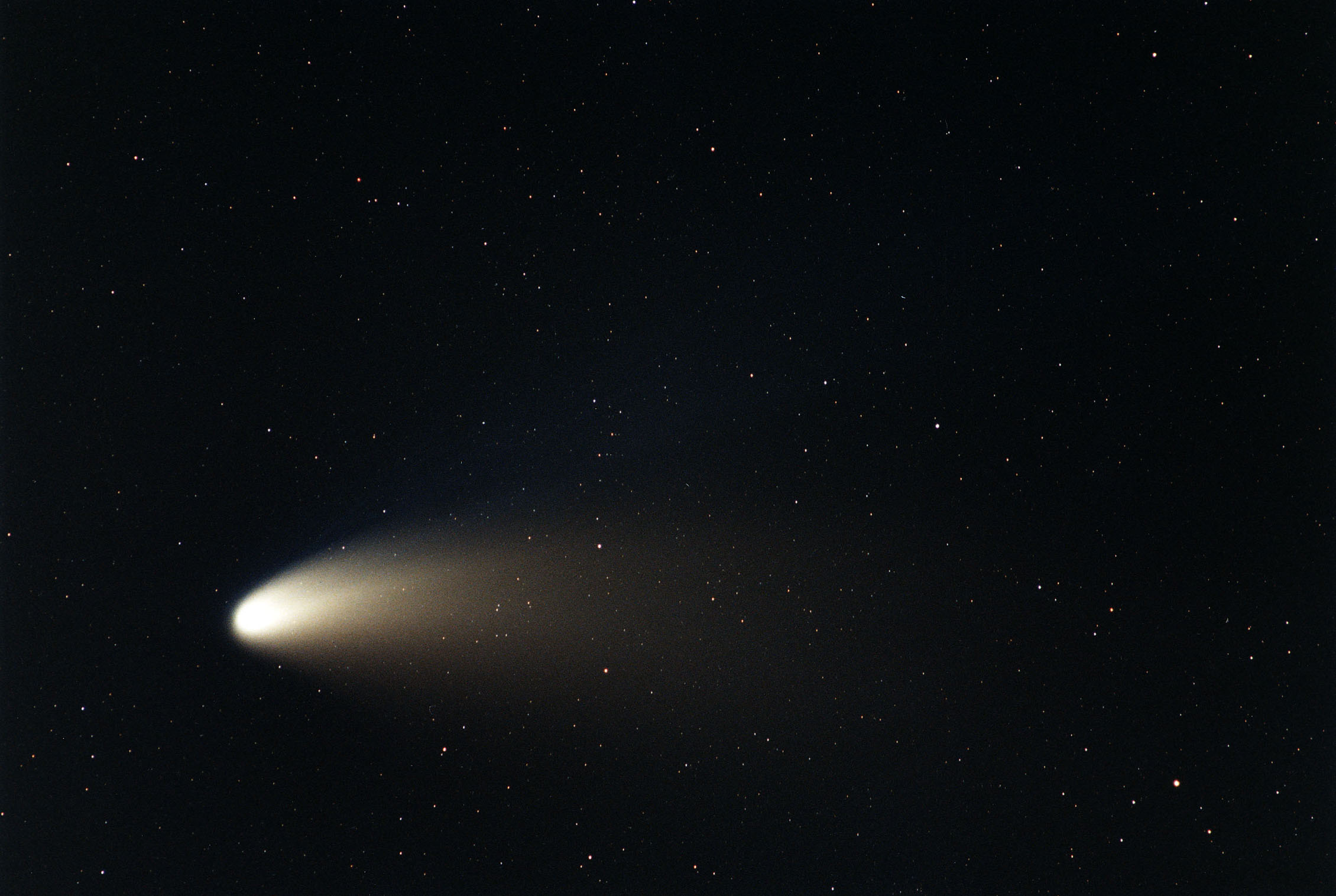
The illustrations and brief descriptions in this chapter pose many interesting questions about the origins and histories of planetary bodies and, not the least among them, Earth itself. A few of these questions have already been alluded to, others are listed here.
Our approach to obtaining answers to these questions is to describe the planets as geologic entities and proceed from observations to deductions about their origins and developmental histories. As we explore the planets of the solar system, we will try to reveal the fundamentals of planetary evolution and how energy causes planets to change. The characteristics of all planets---their compositions, internal structures, orbital paths, shapes, sizes, and especially their surface features---are reflections of the events and processes which shaped them. Thus, our objective is to show how planets originate and evolve by carefully examining them as individuals and comparing them with one another. Ultimately, we will understand some of the reasons why they are different. In this process, we hope to gain a better understanding of our own Earth and how it functions in its unique place in the solar system.